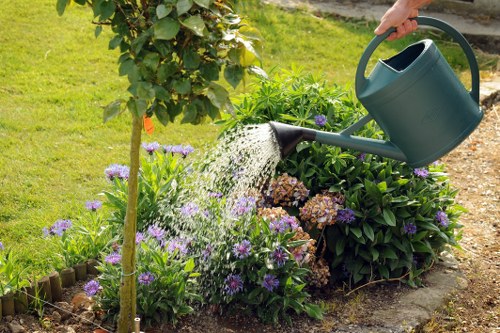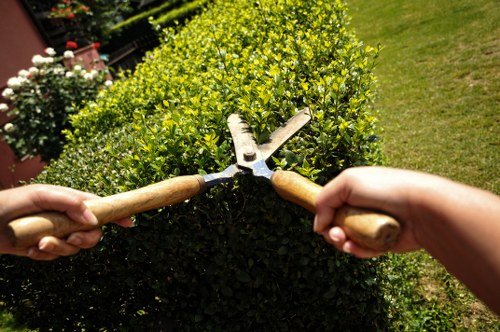Mastering Hedge Trimming in Cleaners KT2: A Comprehensive Guide

Introduction to Hedge Trimming
Maintaining a well-groomed hedge is essential for the aesthetic appeal and health of your garden. Hedge trimming not only enhances the beauty of your outdoor space but also promotes the longevity and vitality of your plants. In Cleaners KT2, professional hedge trimming services are in high demand, catering to both residential and commercial properties.
Understanding the importance of regular hedge trimming can transform your garden into a picturesque retreat. This guide delves into the techniques, benefits, and best practices of hedge trimming specific to the Cleaners KT2 area.
Whether you're a seasoned gardener or a homeowner looking to maintain your green spaces, this comprehensive overview will equip you with the knowledge to achieve immaculate hedges. From the types of tools required to the optimal trimming schedules, we cover it all.

The Importance of Regular Hedge Trimming
Regular hedge trimming is crucial for several reasons. It promotes healthy growth by removing dead or diseased branches, allowing sunlight and air to reach the inner parts of the hedge. This process prevents pests and diseases from taking hold, ensuring your hedges remain lush and vibrant.
In addition to health benefits, trimmed hedges contribute significantly to the overall aesthetics of your property. They provide structure and definition to garden spaces, creating a visually appealing environment. Well-maintained hedges can also serve as natural fences, offering privacy and reducing noise pollution.
Moreover, timely trimming helps in controlling the size and shape of hedges, preventing them from becoming overgrown and unmanageable. This not only makes maintenance easier but also enhances the safety of your outdoor spaces by eliminating potential hazards.
Health Benefits for Your Hedges
- Promotes New Growth: Trimming encourages the development of new shoots, resulting in fuller and denser hedges.
- Prevents Disease: Removing diseased or damaged branches reduces the risk of infections spreading.
- Enhances Air Circulation: Properly trimmed hedges allow better airflow, minimizing moisture buildup that can lead to fungal growth.
Maximizing Aesthetic Appeal
Aesthetically pleasing hedges can significantly enhance the curb appeal of your property. By maintaining a uniform shape and size, trimmed hedges create a clean and organized look. This not only impresses visitors but also increases the value of your home.

Choosing the Right Tools for Hedge Trimming
Equipping yourself with the appropriate tools is essential for effective hedge trimming. The right equipment ensures precision, reduces effort, and minimizes the risk of damage to your plants.
Common tools used in hedge trimming include:
- Pruning Shears: Ideal for small branches and fine detailing.
- Electric Hedge Trimmers: Suitable for larger hedges, offering efficiency and ease of use.
- Manual Hedge Saws: Perfect for thick or stubborn branches that require more force.
Safety Gear Essentials
Safety should always be a priority when performing hedge trimming. Wearing protective gear such as gloves, safety goggles, and sturdy footwear can prevent injuries and ensure a safe trimming experience.
Maintenance of Trimming Tools
Proper maintenance of your trimming tools extends their lifespan and ensures optimal performance. Regular cleaning, sharpening blades, and storing tools in a dry place are crucial steps to keep your equipment in top condition.

Step-by-Step Guide to Hedge Trimming
Executing a successful hedge trimming session involves several steps, each contributing to the overall health and appearance of your hedges.
Follow this step-by-step guide to achieve professional results:
- Assess the Hedge: Examine the current state of your hedge to identify areas that need trimming.
- Choose the Right Time: The best time for hedge trimming is during the growing season, typically spring or early summer.
- Prepare Your Tools: Ensure all trimming tools are clean and sharp.
- Begin Trimming: Start from the bottom and work your way up, maintaining a consistent shape.
- Shape the Hedge: Aim for a natural, tapered shape to allow sunlight to penetrate the inner foliage.
- Clean Up: Remove all trimmings from the area to prevent pests and diseases.
Techniques for Different Hedge Types
Different hedge species require specific trimming techniques. Understanding these nuances ensures that you cater to the unique needs of each type, promoting their health and aesthetic appeal.
Formal vs. Informal Trimming
Formal trimming involves creating precise, geometric shapes, suitable for topiaries and manicured gardens. Informal trimming, on the other hand, allows for a more natural look, perfect for blending hedges with the surrounding landscape.

Common Mistakes to Avoid in Hedge Trimming
Avoiding common pitfalls can make a significant difference in the outcome of your hedge trimming efforts. Here are some mistakes to steer clear of:
- Trimming at the Wrong Time: Cutting hedges during dormant seasons can stunt their growth.
- Over-Trimming: Removing too much foliage can stress the plants and make them susceptible to diseases.
- Ignoring Plant Health: Trimming diseased or damaged branches without proper disposal can spread infections.
Maintaining Consistency
Consistency in trimming ensures that your hedges maintain a uniform appearance. Irregular trimming can result in an unkempt and unattractive garden.
Proper Disposal of Trimmings
Ensure that all trimmings are disposed of correctly to prevent the spread of pests and diseases. Composting or using designated green waste bins are effective disposal methods.
Using Professional Services
If you're unsure about trimming your hedges yourself, consider hiring professional hedge trimming services in Cleaners KT2. Professionals have the expertise and equipment to deliver optimal results, saving you time and effort.
Benefits of Hiring Professional Hedge Trimmers in Cleaners KT2
Engaging professional hedge trimmers in Cleaners KT2 offers numerous advantages. Professionals bring experience, precision, and efficiency to the task, ensuring your hedges look their best.
They are well-versed in the specific needs of different hedge species, allowing them to tailor their approach for maximum benefit. Additionally, professionals have access to advanced tools and equipment, facilitating high-quality trims.
Moreover, hiring experts saves you valuable time and reduces the physical strain associated with manual trimming. It also ensures that the job is done safely, mitigating the risk of accidents or injuries.
Cost-Effectiveness
While there is an upfront cost to hiring professionals, the long-term benefits often outweigh the expenses. Properly trimmed hedges require less maintenance and are less likely to suffer from diseases, saving you money in the long run.
Enhanced Property Value
Well-maintained hedges contribute to the overall appeal of your property, potentially increasing its market value. This is particularly beneficial if you're considering selling your home in the future.
Time-Saving
Professional services allow you to focus on other aspects of garden maintenance or personal activities, freeing up your schedule while ensuring your hedges receive the attention they deserve.
- Expertise: Professionals understand the optimal trimming techniques for various hedge types.
- Efficiency: They complete the task quickly and effectively, minimizing disruption to your daily routine.
- Quality: The results are consistently high, enhancing the beauty of your garden.
Seasonal Hedge Trimming: Best Practices
Seasonal hedge trimming ensures that your hedges remain healthy and aesthetically pleasing throughout the year. Each season presents unique challenges and opportunities for hedge maintenance.
Spring is an ideal time for rejuvenating your hedges, encouraging new growth after the winter months. Summer trimming helps in controlling the size and shape, preventing overgrowth. In autumn, trimming prepares hedges for the colder months, while winter pruning can be done on certain hardy species.
Spring Trimming Techniques
During spring, focus on removing any winter damage and shaping the hedges to prepare them for the growing season. This is the time to address any structural issues and promote vigorous new growth.
Summer Maintenance
In the summer, regular maintenance trims help manage the hedge's size and density, ensuring adequate airflow and sunlight exposure. This prevents the hedge from becoming too thick and reduces the risk of fungal diseases.
Autumn and Winter Care
Autumn trimming involves cutting back any excessively long branches and preparing the hedge for winter. In winter, it's best to perform light pruning on species that are less susceptible to frost damage, maintaining their shape without stressing the plants.
Choosing the Right Hedge Variety for Your Garden
Selecting the appropriate hedge variety is fundamental to achieving the desired look and functionality in your garden. Different hedge species offer varying levels of growth, foliage density, and maintenance requirements.
In Cleaners KT2, popular hedge varieties include:
- Boxwood: Known for its dense, evergreen foliage, ideal for formal gardens.
- Privet: Fast-growing and versatile, suitable for both formal and informal settings.
- Holly: Offers vibrant berries and glossy leaves, adding color and texture.
- Laurel: Robust and hardy, perfect for creating natural barriers.
Factors to Consider When Choosing Hedges
When selecting hedge varieties, consider factors such as climate adaptability, growth rate, maintenance needs, and visual appeal. Choosing the right type ensures that your hedges thrive and complement your garden's overall design.
Climate Adaptability
Ensure that the hedge species you choose are well-suited to the Cleaners KT2 climate. This adaptability affects their growth patterns, resilience to local pests, and overall health.
Maintenance Requirements
Different hedge species have varying maintenance needs. Some require regular trimming to maintain their shape, while others are more forgiving and require minimal upkeep. Assess your willingness and ability to maintain your hedges before making a selection.
Eco-Friendly Hedge Trimming Practices
Adopting eco-friendly practices in hedge trimming can contribute to environmental sustainability and reduce your garden's ecological footprint. Here are some tips to make your trimming routine more environmentally conscious:
- Use Electric Tools: Opt for electric hedge trimmers over gas-powered ones to reduce emissions.
- Compost Trimmings: Turn hedge clippings into compost to enrich your soil naturally.
- Choose Organic Pruning Solutions: Use organic fertilizers and pest control methods to maintain hedge health without harmful chemicals.
Water Conservation Tips
Proper trimming can enhance water retention in your hedges by allowing better airflow and reducing unnecessary water consumption. Mulching around hedges after trimming can also help in conserving moisture and preventing weed growth.
Protecting Local Wildlife
Ensure that your trimming practices do not disrupt the habitat of local wildlife. Avoid cutting during nesting seasons and maintain some natural foliage to provide shelter and food sources for birds and beneficial insects.
Reducing Waste
Minimize waste by using all parts of the trimmed hedges. Branches and leaves can be repurposed for composting, mulch, or even as natural decorations during festive seasons.
Innovative Hedge Trimming Techniques
Staying updated with the latest hedge trimming techniques can enhance the efficiency and results of your trimming sessions. Innovative methods not only save time but also contribute to the health and appearance of your hedges.
Techniques such as topiary, espalier, and selective pruning offer creative ways to shape and manage your hedges. These methods allow for artistic expression while maintaining the functionality and health of the plants.
Topiary: Artistic Hedge Shaping
Topiary involves trimming hedges into intricate shapes and designs, adding an element of artistry to your garden. This technique requires precision and patience but results in visually stunning landscapes.
Espalier: Horizontal Hedge Training
Espalier is a technique where hedges are trained to grow flat against a support structure, such as a wall or fence. This method saves space and creates a unique visual effect, perfect for narrow gardens.
Selective Pruning
Selective pruning focuses on removing specific branches to encourage desired growth patterns. This method allows for more control over the hedge's shape and density, promoting healthier and more aesthetically pleasing plants.
Maintenance Schedule for Optimal Hedge Health
Establishing a regular maintenance schedule is key to ensuring the health and beauty of your hedges. A well-planned schedule helps in identifying and addressing issues promptly, preventing long-term damage.
A typical maintenance schedule includes:
- Spring: Rejuvenation trimming, removing winter damage.
- Summer: Regular shaping and size control.
- Autumn: Preparing for winter, removing overgrown branches.
- Winter: Light pruning on hardy species, maintaining overall shape.
Monitoring Hedge Health
Regularly inspect your hedges for signs of distress, such as discolored leaves, pests, or unusual growth patterns. Early detection of issues allows for timely intervention, ensuring the longevity and vitality of your hedges.
Adjusting the Schedule as Needed
Depending on the specific needs of your hedges and seasonal variations in Cleaners KT2, you may need to adjust your maintenance schedule. Flexibility ensures that your hedges receive the appropriate care throughout the year.
Record-Keeping for Hedge Maintenance
Keeping detailed records of your hedge trimming activities can help in tracking growth patterns, identifying persistent issues, and planning future maintenance more effectively.
Advanced Tools and Technology in Hedge Trimming
The integration of advanced tools and technology in hedge trimming has revolutionized garden maintenance. These innovations enhance precision, efficiency, and safety, making hedge trimming more accessible and effective.
Modern hedge trimmers feature ergonomic designs, lightweight materials, and enhanced safety mechanisms, reducing the physical strain on users while improving trimming accuracy. Additionally, battery-powered and cordless trimmers offer greater mobility and ease of use.
Smart Hedge Trimmers
Smart hedge trimmers equipped with sensors and automated features can adjust trimming angles and power levels based on the hedge's density and thickness. This ensures consistent results and minimizes the risk of over-trimming.
Eco-Friendly Trimming Solutions
Innovative eco-friendly trimming solutions, such as solar-powered trimmers and biodegradable maintenance products, support sustainable gardening practices and reduce environmental impact.
Integrated Garden Management Systems
Integrated garden management systems allow gardeners to monitor and control hedge trimming schedules, tool maintenance, and plant health through centralized platforms, enhancing overall garden management efficiency.
DIY Hedge Trimming vs. Professional Services
Deciding between DIY hedge trimming and hiring professional services depends on several factors, including your expertise, available time, and the complexity of the job.
While DIY trimming can be cost-effective and offer a sense of personal accomplishment, it requires a certain level of skill and the right tools to achieve professional results. On the other hand, professional services bring expertise, efficiency, and high-quality outcomes, ensuring your hedges receive the best possible care.
Pros and Cons of DIY Trimming
- Pros: Cost savings, personal satisfaction, flexible scheduling.
- Cons: Requires time, skill, and proper tools; potential for mistakes.
Advantages of Professional Services
Professional hedge trimming services offer expertise in handling various hedge types, access to advanced tools, and efficient completion of tasks. They ensure that your hedges are trimmed correctly, promoting their health and appearance.
When to Hire a Professional
Consider hiring a professional for large or complex trimming jobs, when dealing with diseased or damaged hedges, or if you lack the necessary tools and expertise for effective trimming.
Environmental Impact of Hedge Trimming
Hedge trimming practices can significantly impact the local environment. Sustainable trimming methods promote biodiversity, reduce waste, and conserve resources, contributing to a healthier ecosystem.
Implementing environmentally friendly practices in hedge trimming ensures that your gardening activities support the well-being of local flora and fauna, maintain soil health, and minimize pollution.
Promoting Biodiversity
Properly trimmed hedges with diverse plant species provide habitats for various wildlife, including birds, insects, and small mammals. This biodiversity supports ecological balance and enhances the resilience of your garden ecosystem.
Reducing Waste Through Composting
Composting hedge trimmings transforms organic waste into nutrient-rich compost, which can be reused to enrich garden soil. This reduces landfill waste and fosters sustainable gardening practices.
Conserving Water and Resources
Efficient trimming techniques help in reducing water consumption by ensuring that hedges maintain an optimal shape and size, preventing excessive water use and promoting resource conservation.
Conclusion: Achieving Perfect Hedges in Cleaners KT2
Mastering the art of hedge trimming in Cleaners KT2 involves understanding the essential techniques, tools, and best practices that contribute to the health and beauty of your hedges. Whether you choose to undertake the task yourself or hire professional services, the key is consistent and informed maintenance.
By following the guidelines outlined in this comprehensive guide, you can ensure that your hedges remain vibrant, well-shaped, and a standout feature of your garden. Embrace sustainable and efficient trimming practices to enhance your outdoor space while supporting environmental well-being.
Ready to transform your garden with pristine hedges? Contact us today to book your professional hedge trimming service in Cleaners KT2 and experience the difference expert care can make.


